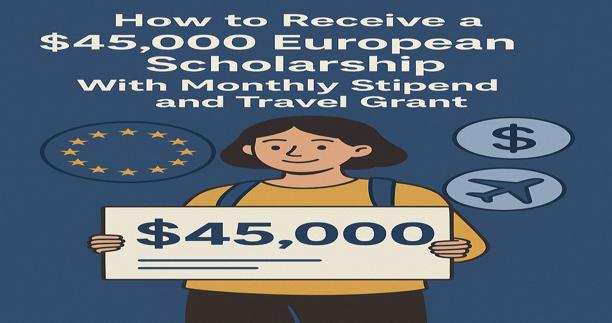Europe is home to some of the oldest and most prestigious universities in the world, offering world-class education across various fields—from engineering and science to arts and social sciences. While many international students dream of studying in Europe, the cost of tuition, accommodation, and living expenses can seem out of reach. Fortunately, numerous fully funded European scholarships—worth up to $45,000—are available. These scholarships often include monthly stipends, tuition waivers, health insurance, and even travel grants.
In this comprehensive guide, you’ll learn how to receive a $45,000 European scholarship that supports you through every stage of your academic journey—without financial stress.
What Does a $45,000 European Scholarship Cover?
A $45,000 scholarship package in Europe typically includes:
-
Full or partial tuition coverage
-
A monthly stipend for living expenses (often between €800 and €1,200)
-
Travel grants to and from your home country
-
Health insurance
-
Visa application and residence permit fees
-
Support for language courses or preparatory programs
-
Access to research, mentorship, and internship opportunities
Some scholarships are for a single academic year, while others are renewable for up to two or more years, particularly at the master’s or PhD level.
Why Study in Europe?
-
Access to world-class universities such as University of Oxford, KU Leuven, University of Helsinki, Sciences Po, and LMU Munich
-
Over 1,500+ programs taught in English across Europe
-
Strong post-study work and immigration pathways
-
Cultural diversity, travel opportunities, and international exposure
-
Generous funding from European governments and institutions
Types of $45,000 Scholarships in Europe With Stipend and Travel Support
1. Government-Funded Scholarships
Many European countries offer scholarships to international students through their ministries of education or foreign affairs.
Examples:
-
Erasmus Mundus Joint Master Degrees
-
DAAD Scholarships (Germany)
-
Swedish Institute Scholarships
-
Czech Government Scholarships
2. University-Specific Scholarships
European universities offer their own funding to attract top international students.
Examples:
-
Sciences Po Emile-Boutmy Scholarship (France)
-
University of Helsinki Scholarship (Finland)
-
KU Leuven Global Minds Doctoral Scholarship (Belgium)
-
Radboud Scholarship Programme (Netherlands)
3. EU-Sponsored Scholarships
Programs funded by the European Union often include tuition coverage, stipends, and generous travel support.
Examples:
-
Erasmus+ Mobility Grants
-
Marie Skłodowska-Curie Fellowships
-
European Research Council Grants (PhD/postdoc level)
Who Can Receive a $45,000 European Scholarship?
While each scholarship has its own eligibility criteria, many are open to:
-
International students from outside the EU/EEA
-
Students with a Bachelor’s degree (for master’s programs) or Master’s degree (for PhDs)
-
Applicants with a strong academic record (though not necessarily perfect)
-
Individuals with a clear study and career plan
-
Candidates who demonstrate leadership potential, community involvement, or research ambition
-
Students from developing countries or countries with limited access to quality education
Step-by-Step Guide to Receiving a $45,000 European Scholarship
Step 1: Research Scholarship Opportunities Early
Start searching at least 12 months before your planned intake. Use platforms like:
-
Individual university websites
Step 2: Choose Programs With Full Financial Support
Focus on degrees that are partnered with scholarship programs. Some European master’s degrees are part of Erasmus Mundus and automatically eligible for funding.
Step 3: Prepare Key Application Documents
Common requirements include:
-
Academic transcripts and degree certificates
-
Proof of English proficiency (IELTS, TOEFL, or university waiver)
-
Statement of Purpose or Motivation Letter
-
Two or more Letters of Recommendation
-
Updated CV or Europass format resume
-
Passport scan
-
Research proposal (for PhD-level scholarships)
Step 4: Craft a Powerful Motivation Letter
Your letter should clearly explain:
-
Why you chose the program and university
-
Your academic and career goals
-
How the scholarship will support your development
-
What makes you a strong candidate
-
How you intend to contribute to your home country or field
Step 5: Apply Directly Through University or Scholarship Portals
Some scholarships are offered as part of your university application, while others require a separate application. Make sure you apply to both the university and the scholarship program.
Step 6: Prepare for Interviews (If Required)
Some programs will invite shortlisted candidates for online interviews to assess motivation, fit, and language skills.

Top $45,000 European Scholarships You Can Apply For
1. Erasmus Mundus Joint Master Degree (EMJMD)
-
Covers tuition, health insurance, monthly stipend (~€1,100/month), and travel allowance
-
Worth up to €49,000 ($52,000) over two years
-
Allows study in 2–3 different European countries
-
No separate visa process—students receive EU-wide permits
2. DAAD Scholarship for Postgraduate Courses
-
For students from developing countries
-
Includes full tuition, €934/month living allowance, health insurance, and travel grant
-
Offered at top German universities in fields like engineering, business, and development
3. Swedish Institute Scholarship for Global Professionals
-
Full tuition at any Swedish university
-
Monthly stipend of SEK 11,000 (~$1,000), travel grant, and insurance
-
No separate IELTS required if previous education was in English
4. Emile Boutmy Scholarship – Sciences Po (France)
-
Up to €19,000 per year for undergraduate and master’s students
-
Covers tuition and offers partial accommodation support
-
Priority given to students from outside the EU
5. Radboud Scholarship Programme (Netherlands)
-
Tuition reduced from €17,000 to €2,200
-
Partial living allowance and visa/travel expenses covered
-
Highly competitive and merit-based
Tips to Boost Your Chances of Winning
-
Start early and create a calendar of deadlines
-
Customize your motivation letter for each program
-
Highlight social impact, leadership, or research achievements
-
Choose referees who know your strengths well
-
Apply for multiple scholarships to increase your odds
-
Demonstrate English proficiency clearly if IELTS is waived
Mistakes to Avoid
-
Submitting a generic or rushed application
-
Ignoring specific eligibility rules
-
Not applying separately to the scholarship and the university
-
Missing deadlines due to time zone differences
-
Forgetting to prepare for visa or residency requirements
What Happens After You Receive the Scholarship?
Once selected, you will receive an official scholarship award letter. Next steps typically include:
-
Assistance with student visa/residence permit
-
Booking flights using the travel grant
-
Receiving pre-departure orientation
-
Opening a European bank account for your stipend
-
Arriving in Europe and beginning your academic program
-
Accessing student housing, university support, and networking events
Many scholarship programs also provide career services, language classes, and internship placements during or after your studies.
Conclusion
Receiving a $45,000 European scholarship is not just about financial relief, it’s about unlocking a world-class education, building a global network, and launching an international career. Whether you’re pursuing a master’s in artificial intelligence, public policy, or environmental engineering, Europe offers rich academic experiences and generous funding to help you thrive.
Start your journey now. Research thoroughly, apply with passion, and believe in your ability to compete globally. The opportunity to study in Europe fully funded, might be just one application away.

